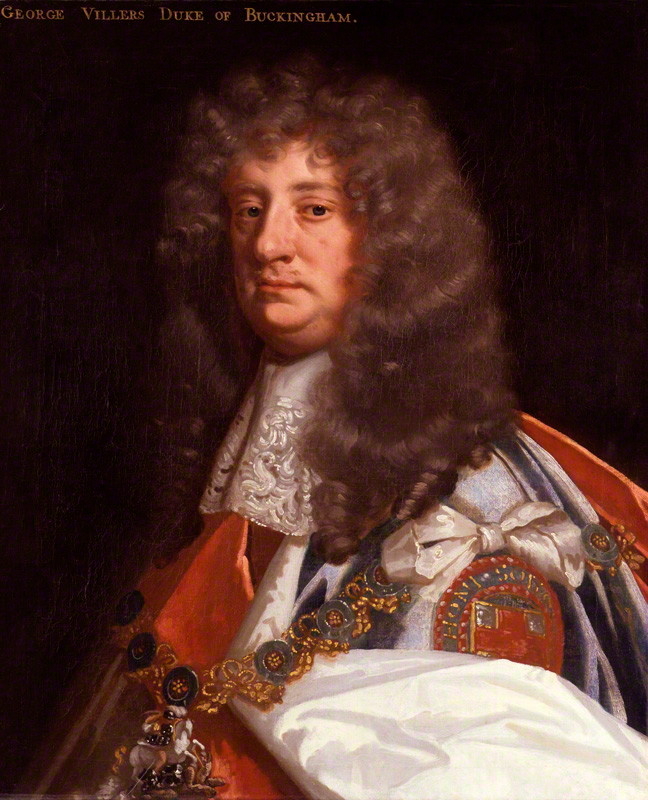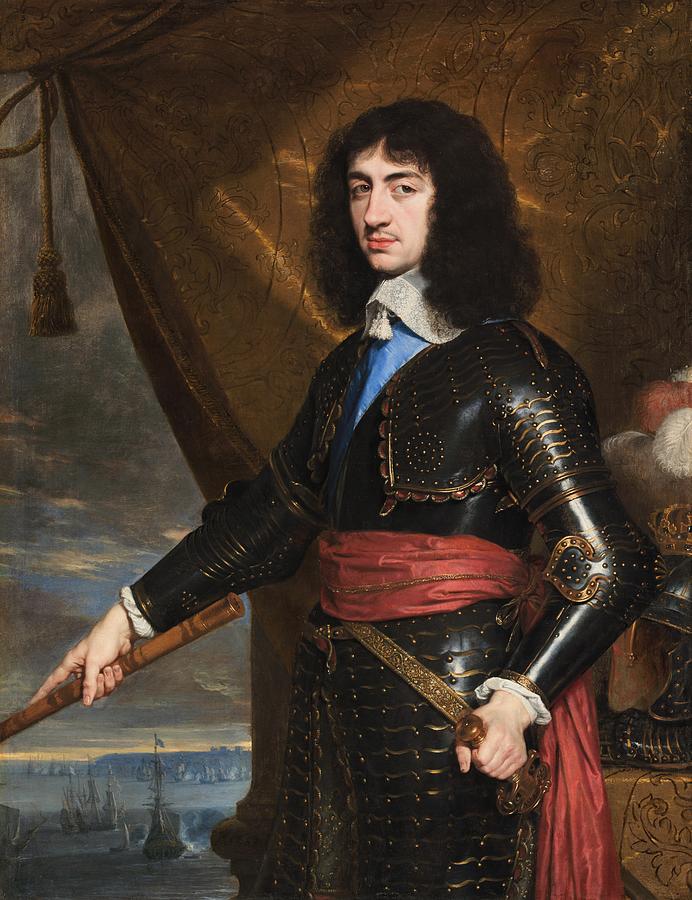by Susan Flantzer
© Unofficial Royalty 2021

George Villiers, 2nd Duke of Buckingham; Credit – Wikipedia
Favorite: a person treated with special or undue favor by a king, queen, or another royal person
A member of the Villiers family, a prominent aristocratic family during the Stuart dynasty, George Villiers, 2nd Duke of Buckingham was born on January 30, 1628, during the reign of King Charles I of England. He was the third of the four children and the second but the eldest surviving of the three sons of George Villiers, 1st Duke of Buckingham and Katherine Manners. George was a half-first cousin once removed of King Charles II’s mistress, Barbara Palmer, 1st Duchess of Cleveland, who was born as Barbara Villiers. Barbara’s father, William Villiers, 2nd Viscount Grandiso,n was the son of Sir Edward Villiers, a half-brother of George Villiers, 1st Duke of Buckingham.

George (on his mother’s lap) with his parents and his sister Mary; Credit – Wikipedia
George had three siblings:
- Mary Villiers (1622 – 1685), married (1) Charles Herbert, Lord Herbert, no children (2) James Stewart, 1st Duke of Richmond, 4th Duke of Lennox, had two children (3) Colonel Thomas Howard, no children
- Charles Villiers, Earl of Coventry (1625 – 1627), died in childhood
- Lord Francis Villiers (1629 – 1648), unmarried, died in a skirmish at Kingston-Upon-Thames during the Second English Civil War
The elder George Villiers, the 1st Duke of Buckingham, was a courtier and favorite of King James I of England and his son King Charles I until a disgruntled army officer assassinated him on August 23, 1628. His seven-month-old son George inherited his father’s wealth and his long string of titles: Duke of Buckingham, Marquess of Buckingham, Earl of Buckingham, Earl of Coventry, Viscount Villiers, and Baron Whaddon. George’s mother Katherine succeeded to one of her father’s titles, Baron de Ros of Helmsley upon his death in 1632, becoming the 18th Baroness de Ros of Helmsley in her own right. In 1635, she married for a second time to Randal MacDonnell, 1st Marquess of Antrim, and went to live at Dunluce Castle in County Antrim, Ireland. Katherine survived her first husband by twenty-one years, dying in 1649 in Waterford, Ireland, probably of the plague. Upon his mother’s death, George inherited her title Baron de Ros of Helmsley.

George Villiers, 2nd Duke of Buckingham and his brother Lord Francis Villiers; Credit – Wikipedia
George Villiers, 2nd Duke of Buckingham and his brother Lord Francis Villiers were brought up in the household of King Charles I with Charles I’s sons, the future King Charles II and the future King James II. King Charles I took responsibility for George and Francis because of his loyalty to their assassinated father and because he did not think their Catholic mother should raise them. The education of the two Villiers boys and the two royal princes was overseen by William Cavendish, 1st Duke of Newcastle and Brian Duppa, Bishop of Winchester, and then later by John Earle, Bishop of Salisbury. The philosopher Thomas Hobbes was their mathematics teacher.
George and his brother Francis actively supported and fought with the Royalists during the English Civil War. After the death of his brother in a battle near Kingston upon Thames, George Villiers fled England and took refuge like many other royalists in the Netherlands. The execution of King Charles I on January 30, 1649, made his son Charles the de jure King of England. Because George participated in the Royalist cause, his property in England was confiscated, but King Charles II, in exile, made him a Knight of the Garter in 1649 and a member of the Privy Council in 1650.

King Charles II in exile, 1653; Credit – Wikipedia
In 1650, accompanied by George, Charles II landed in Scotland and raised an army of 10,000 men. After being crowned King of Scots at Scone on January 1, 1651, Charles marched his army into England but was overwhelmingly defeated at the Battle of Worcester. After being a fugitive for six weeks, Charles escaped England and fled to France. Oliver Cromwell was declared Lord Protector of the Commonwealth of England, Scotland, and Ireland. England remained a Commonwealth and then a Protectorate until 1660.
George followed the English royal family into exile. He returned to England in 1657 and married Mary Fairfax, the only child and heir of Thomas Fairfax, 3rd Lord Fairfax of Cameron. After the Cromwell government confiscated George’s property, it was given to Mary’s father, Thomas Fairfax. George hoped that the marriage would result in him getting back his property. George and Mary’s marriage was childless. Mary was a Lady of the Bedchamber to Charles II’s wife, Catherine of Braganza, from 1663 to 1688.
In 1658, George was suspected of organizing a plot against Cromwell’s government. He was placed under house arrest at York House, his home in London, but escaped. When he was captured, he was imprisoned in the Tower of London until his father-in-law negotiated his release in 1659. The conditions of George’s release were a promise not to assist the enemies of the government and a large security payment from his father-in-law Thomas Fairfax.
On September 3, 1658, Oliver Cromwell died. His son Richard Cromwell ruled only until April 1659, and there was a real possibility for the restoration of the monarchy. On May 1, 1660, Parliament formally invited Charles, as King Charles II, to be the English monarch in what has become known as the Restoration. On May 23, 1660, Charles landed at Dover, England, and on his 30th birthday, May 29, 1660, King Charles II entered London in a procession with George Villiers, 2nd Duke of Buckingham accompanying the king.
After the restoration of King Charles II, George held several positions, including Lord Lieutenant of the West Riding of Yorkshire, Minister of State, and Master of the Horse. His endeavor to influence English politics was stymied by the Lord Chancellor Edward Hyde, 1st Earl of Clarendon. In 1667, George took an active part in the overthrow of Hyde. He then played an important role in the group of five royal advisors that called itself the CABAL, formed from the letters of its members’ names:
C (Sir Thomas Clifford)
A (Anthony Ashley-Cooper, Baron Ashley)
B (George Villiers, 2nd Duke of Buckingham)
A (Henry Bennet, 1st Earl of Arlington)
L (John Maitland, 2nd Earl of Lauderdale)

George’s mistress Anna Maria Talbot, Countess of Shrewsbury; Credit – Wikipedia
George was one of the Restoration rakes, which included John Wilmot, 2nd Earl of Rochester, Sir Charles Sedley, and Charles Sackville, 6th Earl of Dorset. Following the example of King Charles II, they distinguished themselves in drinking, sex, and witty conversation. In 1667, George began an affair with Anna Maria Talbot, Countess of Shrewsbury, the wife of Francis Talbot, 11th Earl of Shrewsbury. The Earl challenged George to a duel and was mortally wounded by George, dying two months later of his injury. After the death of the 11th Earl of Shrewsbury, his widow Anna Maria went to live with George, which necessitated George’s wife Mary living in the home of her birth family until the affair ended in 1674.

The Life of Buckingham by Augustus Leopold Egg – George is the central figure with King Charles II standing behind him; Credit – Wikipedia
In 1674, the House of Commons and the House of Lords brought charges against George. He was accused of embezzling public funds, having secret negotiations with France, and condemned for his affair with Anna Maria Talbot, Countess of Shrewsbury. Due to a petition from the House of Commons, George was removed from office by Charles II and resigned from the royal advisory group. However, as a peer, he was still a member of the House of Lords and participated in the business of the House of Lords. Personally, George reformed his ways, reconciled with his wife Mary, and began to pay his debts.
After the death of King Charles II in 1685, George retired to his estate in Helmsley, North Yorkshire, England. He died there on April 16, 1687, aged 59, from complications of a cold he caught while participating in a fox hunt. Originally buried in Yorkshire, on June 7, 1687, George’s remains were moved to the Buckingham Vault in the Chapel of St. Nicholas in Westminster Abbey in London, England. While his father has a lavish tomb with an effigy in the Chapel of St. Nicholas, George has no monument or marker. Because George had no legitimate male heir, his titles became extinct except for Baron de Ros of Helmsley from his mother’s family, which fell into abeyance until 1790. George’s wife Mary survived him by seventeen years, dying on October 30, 1704, aged 67. She was buried with her husband in the Buckingham Vault in Westminster Abbey.
Embed from Getty Images
The Chapel of St. Nicholas at Westminster Abbey, where George and his wife Mary are buried in the Buckingham Vault
This article is the intellectual property of Unofficial Royalty and is NOT TO BE COPIED, EDITED, OR POSTED IN ANY FORM ON ANOTHER WEBSITE under any circumstances. It is permissible to use a link that directs to Unofficial Royalty.
Works Cited
- En.wikipedia.org. 2020. George Villiers, 2Nd Duke Of Buckingham. [online] Available at: <https://en.wikipedia.org/wiki/George_Villiers,_2nd_Duke_of_Buckingham> [Accessed 31 December 2020].
- Flantzer, Susan. 2016. King Charles II Of England. [online] Unofficial Royalty. Available at: <https://www.unofficialroyalty.com/king-charles-ii-of-england/> [Accessed 31 December 2020].
- Flantzer, Susan. 2020. George Villiers, 1st Duke of Buckingham, Favorite of King James I of England and King Charles I of England. Available at: <https://www.unofficialroyalty.com/george-villiers-1st-duke-of-buckingham-favorite-of-king-james-i-of-england-and-king-charles-i-of-england/> [Accessed 31 December 2020].
- Fr.wikipedia.org. 2020. George Villiers (2E Duc De Buckingham). [online] Available at: <https://fr.wikipedia.org/wiki/George_Villiers_(2e_duc_de_Buckingham)> [Accessed 31 December 2020].
- Nl.wikipedia.org. 2020. George Villiers (1628-1687). [online] Available at: <https://nl.wikipedia.org/wiki/George_Villiers_(1628-1687)> [Accessed 31 December 2020].
- Westminster Abbey. 2020. Villiers Family | Westminster Abbey. [online] Available at: <https://www.westminster-abbey.org/abbey-commemorations/commemorations/villiers-family> [Accessed 31 December 2020].
